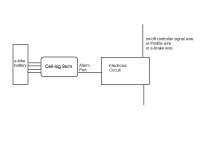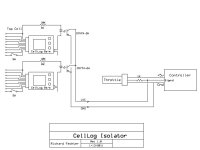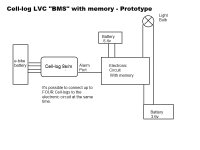CanadianWinters
100 W
Hi everyone,
A few weeks ago I was thinking to use the cell-log alarm port to build a sort of BMS. I did several searches on the forum and google but nothing useful came up.
My aim was to use the lvc alarm of the cell-log to stop the load, not directly on a power wire but indirectly, on the throttle or the thin red wire used to "switch on" the controller or the e-brake wire. Basically anything that can stop the discharge of the battery without interfering with any power wires.
This to keep things simple,safe and also cheap.
So, with the help of a friend, I decided to build a little circuit using a mosfet as a switch.

This is the video of the first prototype. In this case the mosfet is placed on the load just to check if the circuit was working.
[youtube]yF3vf4YXSDI[/youtube]
As you can see from the video the load is cut and then uncut until the battery will stay constantly under the lvc set on the cell-log.
To avoid this I will be building another circuit with a "memory", as soon as the alarm will be triggered the first time, the circuit will open and stay open until a button is pressed and the "memory" is reset.
The new circuit will also allow to connect up to 4 cell-logs and will tolerate a maximum voltage of 120v (cells fully charged,not nominal voltages).
I will keep you posted!
A few weeks ago I was thinking to use the cell-log alarm port to build a sort of BMS. I did several searches on the forum and google but nothing useful came up.
My aim was to use the lvc alarm of the cell-log to stop the load, not directly on a power wire but indirectly, on the throttle or the thin red wire used to "switch on" the controller or the e-brake wire. Basically anything that can stop the discharge of the battery without interfering with any power wires.
This to keep things simple,safe and also cheap.
So, with the help of a friend, I decided to build a little circuit using a mosfet as a switch.

This is the video of the first prototype. In this case the mosfet is placed on the load just to check if the circuit was working.
[youtube]yF3vf4YXSDI[/youtube]
As you can see from the video the load is cut and then uncut until the battery will stay constantly under the lvc set on the cell-log.
To avoid this I will be building another circuit with a "memory", as soon as the alarm will be triggered the first time, the circuit will open and stay open until a button is pressed and the "memory" is reset.
The new circuit will also allow to connect up to 4 cell-logs and will tolerate a maximum voltage of 120v (cells fully charged,not nominal voltages).
I will keep you posted!




